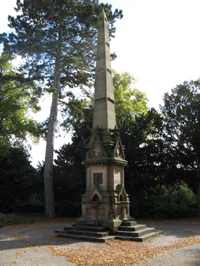 Rather than a street name, this time we consider the person behind a little-known monument, which stands near to where Victoria Avenue (which runs beside the River Severn at the bottom of the Quarry) joins St Julian’s Friars. This commemorates William James Clement (1802-70), a surgeon, philanthropist and Liberal politician.
Rather than a street name, this time we consider the person behind a little-known monument, which stands near to where Victoria Avenue (which runs beside the River Severn at the bottom of the Quarry) joins St Julian’s Friars. This commemorates William James Clement (1802-70), a surgeon, philanthropist and Liberal politician.

After attending Shrewsbury School, Clement studied medicine and surgery at the Middlesex Hospital and Edinburgh Medical School. While in London, his mentor was the renowned anatomist and surgeon Sir Charles Bell, who operated on the wounded at the Battle of Waterloo until ‘his clothes were stiff with blood, and his arms powerless with the exertion of using the knife’, as one admirer wrote. Like his mentor, Clement also combined intellectual ability with practical surgical skill. As a young man he wrote two medical textbooks, which were translated into French and German. When he returned to settle in Shrewsbury he demonstrated to the other surgeons at the Infirmary how to remove a bladder stone in a child in two minutes (without anaesthetic), and he also performed lifesaving tracheotomy operations. So it was hardly surprising that when a surgical vacancy arose at the Salop Infirmary in 1835, Clement was the obvious choice. The only problem was his outspoken radical politics.

In 1832 parliament had begun to reform itself, and in 1835 it was the turn of local government, when the Municipal Corporations Act was having a stormy passage into law. This act would at a stroke sweep away the Tory-dominated Shrewsbury Corporation, which had existed for hundreds of years. Naturally the Tories did not relish the prospect, and they were even more furious with Clement who publicly demanded ‘a speedy reform of all rotten corporations’. A large group, including many of the most influential people in the county, met and agreed never to employ Clement themselves, and also to make every attempt to hinder his career. Many such people were trustees of the Infirmary, and as such were able to vote in the election for the surgical vacancy. And so Clement was rejected, and John Dickin (a ‘nonentity’ according to one Shrewsbury Chronicle correspondent) was appointed instead. But this was not the end of the controversy at the Infirmary, for, as was described in the previous article, Dr Proud Johnson, Physician, and Henry Keate, surgeon, were dismissed in similarly acrimonious circumstances four years later. Yes, they broke the rules, but Clement’s enemies would not forgive the two doctors for removing a patient from the hospital so that he could be operated on by William Clement in his rooms.
But none of this seemed to harm Clement’s professional or political career. He continued to pioneer heroic surgery, such as performing some of the earliest colostomy operations without anaesthetic. (Dying of intestinal obstruction must have been horrendous, as one of his grateful patients described it, ‘that horrible throwing up [vomiting] of the stools [faeces]’.) Clement was elected a Councillor for the new Borough Council under the Municipal Corporations Act in 1835, and served with distinction on and off for 33 years, as his surgical work allowed. He was elected Mayor in 1861-2, and also became an MP, being returned unopposed in a by-election in 1865.

The Clement memorial obelisk was erected in 1873. It stood outside the railway station until 1897, when the station was remodelled, and it was moved to the Dingle, where it was a well-loved local feature. However, when the Dingle was renovated it was moved to its current position, where it became broken and vandalised until a welcome renovation in 2004. How about a plaque nearby to tell the story of this man who gave so much for Shrewsbury?
